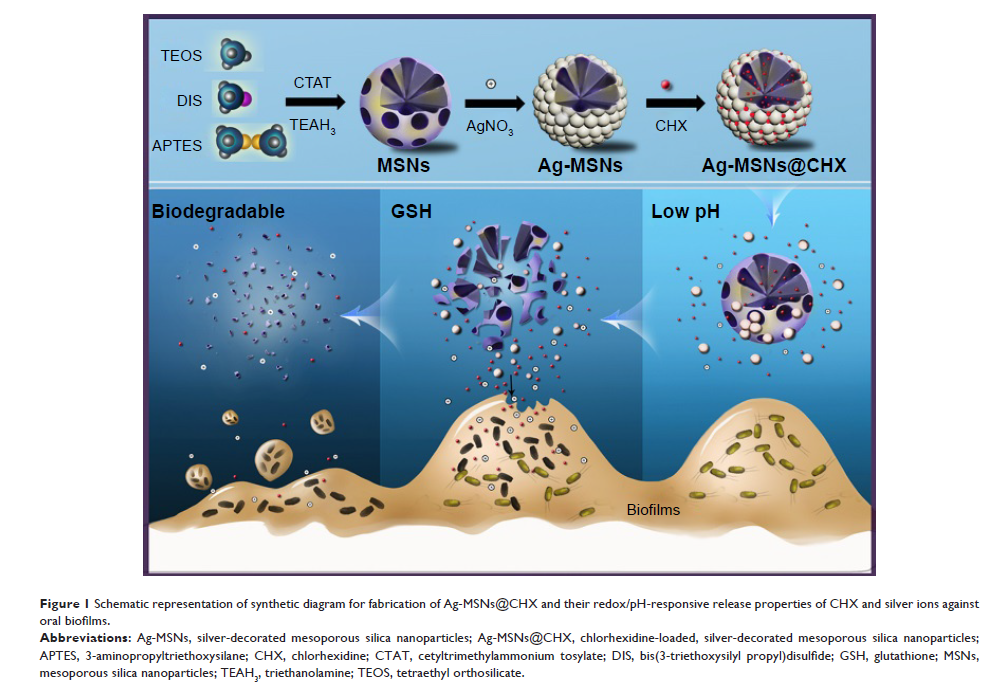9 1 2 3 6
论文已发表
注册即可获取德孚的最新动态
IF 收录期刊
- 2.6 Breast Cancer (Dove Med Press)
- 3.9 Clin Epidemiol
- 3.3 Cancer Manag Res
- 3.9 Infect Drug Resist
- 3.6 Clin Interv Aging
- 4.8 Drug Des Dev Ther
- 2.8 Int J Chronic Obstr
- 8.0 Int J Nanomed
- 2.3 Int J Women's Health
- 3.2 Neuropsych Dis Treat
- 4.0 OncoTargets Ther
- 2.2 Patient Prefer Adher
- 2.8 Ther Clin Risk Manag
- 2.7 J Pain Res
- 3.3 Diabet Metab Synd Ob
- 4.3 Psychol Res Behav Ma
- 3.4 Nat Sci Sleep
- 1.9 Pharmgenomics Pers Med
- 3.5 Risk Manag Healthc Policy
- 4.5 J Inflamm Res
- 2.3 Int J Gen Med
- 4.1 J Hepatocell Carcinoma
- 3.2 J Asthma Allergy
- 2.3 Clin Cosmet Investig Dermatol
- 3.3 J Multidiscip Healthc

氧化还原/pH 双缓释的洗必泰和来自可生物降解介孔二氧化硅纳米粒子的银离子用于抑制口腔生物膜
Authors Lu MM, Ge YR, Qiu J, Shao D, Zhang Y, Bai J, Zheng X, Chang ZM, Wang Z, Dong WF, Tang CB
Received 23 July 2018
Accepted for publication 25 September 2018
Published 19 November 2018 Volume 2018:13 Pages 7697—7709
DOI https://doi.org/10.2147/IJN.S181168
Checked for plagiarism Yes
Review by Single-blind
Peer reviewers approved by Dr Cristina Weinberg
Peer reviewer comments 3
Editor who approved publication: Dr Linlin Sun
Background: Oral plaque biofilms pose a threat to
periodontal health and are challenging to eradicate. There is a growing belief
that a combination of silver nanoparticles and chlorhexidine (CHX) is a
promising strategy against oral biofilms.
Purpose: To
overcome the side effects of this strategy and to exert maximum efficiency, we
fabricated biodegradable disulfide-bridged mesoporous silica nanoparticles
(MSNs) to co-deliver silver nanoparticles and CHX for biofilm inhibition.
Materials and methods: CHX-loaded, silver-decorated mesoporous silica nanoparticles
(Ag-MSNs@CHX) were fabricated after CHX loading, and the pH- and
glutathione-responsive release profiles of CHX and silver ions along with their
mechanism of degradation were systematically investigated. Then, the efficacy
of Ag-MSNs@CHX against Streptococcus mutans and its biofilm was
comprehensively assessed by determining the minimum inhibitory concentration,
minimum bactericidal concentration, minimal biofilm inhibitory concentration,
and the inhibitory effect on S. mutans biofilm formation. In addition, the
biosafety of nanocarriers was evaluated by oral epithelial cells and a mouse
model.
Results: The
obtained Ag-MSNs@CHX possessed redox/pH-responsive release properties of CHX
and silver ions, which may be attributed to the redox-triggered matrix
degradation mechanism of exposure to biofilm-mimetic microenvironments.
Ag-MSNs@CHX displayed dose-dependent antibacterial activity against planktonic
and clone formation of S. mutans . Importantly, Ag-MSNs@CHX had an increased
and long-term ability to restrict the growth of S. mutans biofilms
compared to free CHX. Moreover, Ag-MSNs@CHX showed less cytotoxicity to oral
epithelial cells, whereas orally administered Ag-MSNs exhibited no obvious
toxic effects in mice.
Conclusion: Our
findings constitute a highly effective and safe strategy against biofilms that
has a good potential as an oral biofilm therapy.
Keywords: biodegradable
mesoporous silica nanoparticles, silver nanoparticles, chlorhexidine, GSH,
pH-responsive release, biofilm, biocompatibility
